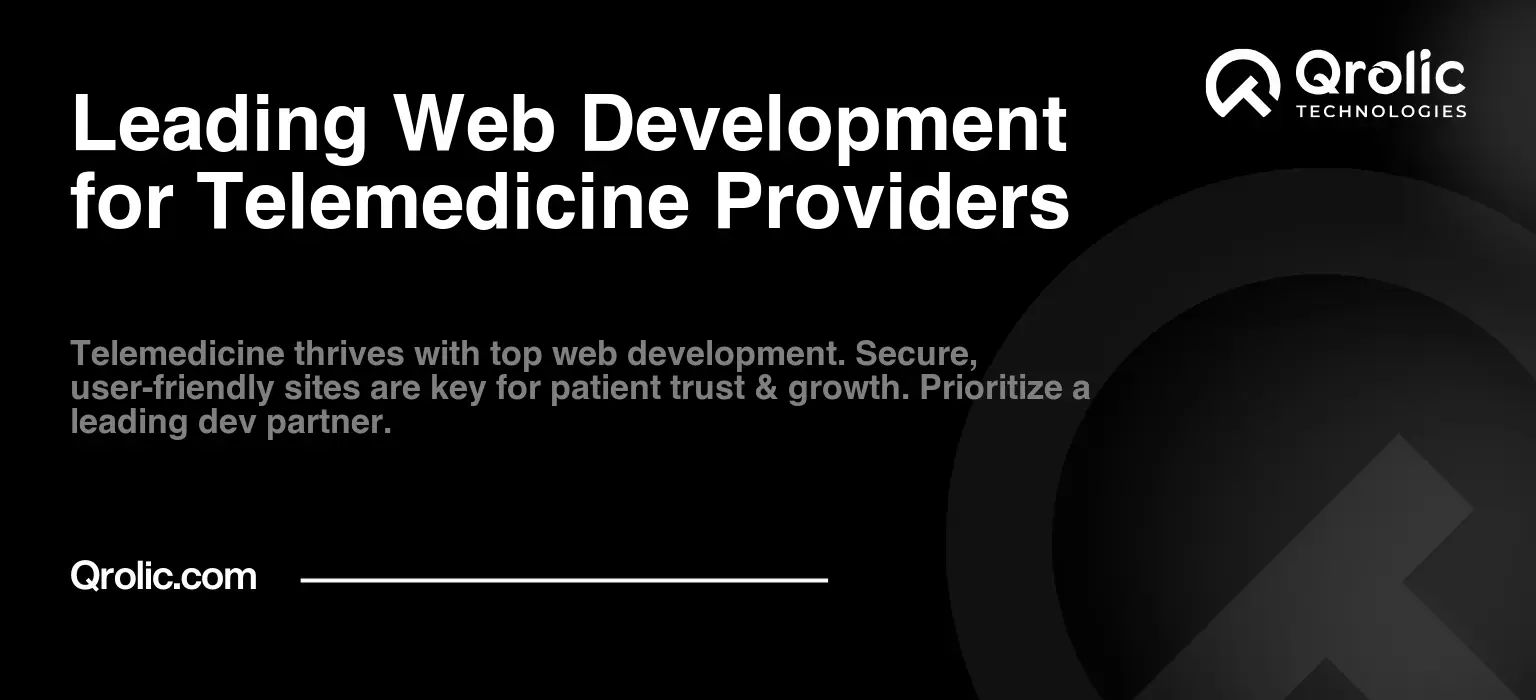Quick Summary:
- A strong website is vital for telemedicine success.
- Prioritize security, easy patient use, and clear information.
- Choose expert web developers understanding healthcare needs.
- Use SEO to attract new patients searching for care.
Table of Contents
- The Digital Doctor’s Office: Why Web Development is Critical for Telemedicine
- Beyond a Basic Website: What Telemedicine Providers Need
- Why Choose a Leading Web Development Provider?
- Key Features of a Successful Telemedicine Website
- User-Centric Design and Navigation
- Secure and HIPAA-Compliant Platform
- Seamless Appointment Scheduling
- Integration with Telemedicine Platform
- Comprehensive Provider Profiles
- Informative and Engaging Content
- Integrated Payment Processing
- The SEO Advantage: Why Search Visibility Matters
- How SEO Impacts Telemedicine Providers
- Key SEO Elements in Web Development
- The Power of Local SEO
- Qrolic Technologies: Your Partner in Telemedicine Web Development
- Why Choose Qrolic Technologies for your Telemedicine Platform?
- Our Telemedicine Web Development Services
- The Future of Telemedicine Web Development
- Emerging Trends in Telemedicine Web Development
- Essential Actions for Telemedicine Providers
The Digital Doctor’s Office: Why Web Development is Critical for Telemedicine
In today’s rapidly evolving healthcare landscape, telemedicine has emerged as a transformative force, bridging geographical gaps and offering convenient access to medical care. However, a successful telemedicine practice isn’t solely about the technology of video conferencing or remote patient monitoring. It hinges upon a robust and well-designed online presence. That’s where leading web development becomes absolutely crucial for telemedicine providers.
Think of your website as the digital front door to your practice. It’s the first impression many patients will have, and it shapes their perception of your services, expertise, and commitment to care. A poorly constructed website can deter potential patients, while a thoughtfully crafted online platform can attract and retain them, fostering trust and driving growth.
Beyond a Basic Website: What Telemedicine Providers Need
While any website can technically be considered an online presence, telemedicine demands more than just a basic template. It needs to address specific needs and functionalities, ensuring a seamless and user-friendly experience for both patients and practitioners. This includes:
- Secure and HIPAA-Compliant Platforms: The protection of patient data is paramount. Web development for telemedicine requires adhering to stringent HIPAA regulations and incorporating robust security measures to safeguard sensitive health information.
- Intuitive Navigation and User Experience: Patients, often stressed or unwell, need easy access to appointment scheduling, medical records, and communication channels. A complicated or confusing website can lead to frustration and abandonment.
- Mobile Optimization: A vast majority of internet users now access the web via mobile devices. Telemedicine websites need to be fully responsive and optimized for viewing on smartphones and tablets.
- Integration with Telemedicine Platforms: The website must smoothly integrate with the chosen telehealth platform, allowing for seamless appointment booking, video consultations, and data sharing.
- Clear Information and Transparency: Patients need readily available information about your services, pricing, accepted insurance, and provider credentials. Clear communication builds trust and credibility.
- Accessible Design: Your website should be accessible to all users, including those with disabilities, through features like alternative text for images, keyboard navigation, and sufficient color contrast.
- Engaging Content: Informative blog posts, articles, and videos can attract and educate potential patients about the benefits of telemedicine and the specific services you offer.
This means that web development for telemedicine is not just about coding; it’s about understanding healthcare, patient needs, and the nuances of the digital environment.
Why Choose a Leading Web Development Provider?
Choosing the right partner for your telemedicine web development project is a pivotal decision. Opting for a provider with a track record of excellence and expertise in the healthcare industry offers distinct advantages:
- Healthcare Industry Expertise: A leading provider understands the complex regulations, security protocols, and specific needs of telemedicine, saving you time, money, and potential headaches. They know that telemedicine demands a specialized approach.
- Customized Solutions: A skilled team can develop a platform tailored to your unique needs and branding, rather than forcing you into a generic template. They will understand your particular workflow and requirements.
- Scalability and Future-Proofing: As your practice grows and telemedicine evolves, your website needs to adapt. A leading developer will design a scalable platform that can accommodate future expansion and technological advancements.
- Ongoing Support and Maintenance: Your website isn’t a "set it and forget it" project. A reliable provider will offer continuous support, updates, and maintenance to ensure optimal performance and security.
- Improved Patient Acquisition and Retention: A user-friendly and professional website will attract new patients and foster loyalty among existing ones. This directly impacts the success of your telemedicine practice.
In summary, when it comes to web development, settling for anything less than the best is a disservice to your practice and, more importantly, to your patients. Investing in leading web development is an investment in the future of your telemedicine services.
Key Features of a Successful Telemedicine Website
Let’s delve deeper into the specific features that contribute to a winning telemedicine website, understanding how web development plays a crucial role in their implementation.
User-Centric Design and Navigation
User experience (UX) is paramount in telemedicine. Patients, often experiencing discomfort or anxiety, need a website that is easy to use, intuitive, and stress-free. This translates to:
- Clear and Simple Navigation: A logical menu structure and prominent call-to-action buttons guide users through the site effortlessly.
- Mobile-First Design: The website must be optimized for seamless viewing on any device, ensuring a consistent experience across desktops, tablets, and smartphones.
- Fast Loading Speed: slow loading times can frustrate users and lead them to abandon your site. Optimization for speed is essential.
- Logical Information Architecture: Information should be organized in a way that is easy to find and digest.
- Accessibility Features: Ensuring that users with disabilities can access all information and features.
How web development achieves this: Skilled developers use a combination of coding best practices, UI/UX design principles, and rigorous testing to ensure a seamless and user-friendly experience. They consider the user journey from the moment they land on the page to when they complete their desired action, like scheduling an appointment.
Secure and HIPAA-Compliant Platform
Protecting patient data is not just a legal requirement, it’s an ethical obligation. A secure platform is non-negotiable for telemedicine providers. This means incorporating:
- HIPAA Compliance: Adherence to all regulations stipulated by the Health Insurance Portability and Accountability Act (HIPAA).
- Data Encryption: Protecting sensitive patient data both in transit and at rest.
- Secure User Authentication: Ensuring only authorized users can access patient information.
- Regular Security Audits: Proactively identifying and addressing any potential vulnerabilities.
- Secure Hosting and Infrastructure: Selecting a reputable hosting provider with robust security measures.
How web development achieves this: Developers utilize encryption protocols, secure coding practices, and regular vulnerability scanning to ensure data protection. They are also knowledgeable about HIPAA regulations and can help guide you in building a compliant platform. They will know that leading in security is a must for telemedicine platforms.
Seamless Appointment Scheduling
Easy appointment booking is a cornerstone of effective telemedicine. This includes:
- Online Scheduling System: Allowing patients to book appointments directly through the website, at their convenience.
- Real-Time Availability: Displaying current practitioner schedules and available time slots.
- Automated Reminders: Sending automated reminders to patients via email or text message to reduce no-shows.
- Integration with Calendar Systems: Synchronizing with the provider’s personal or practice calendar.
- Payment Gateway Integration: Facilitating secure online payments for consultations.
How web development achieves this: Developers integrate online booking software, configure appointment calendars, and set up automated notification systems. They ensure the scheduling process is simple and intuitive for patients.
Integration with Telemedicine Platform
Your website needs to be seamlessly integrated with your chosen telemedicine platform. This involves:
- Direct Links to Virtual Waiting Rooms: Enabling patients to easily access video consultation links.
- Secure Data Transfer: Facilitating the safe transfer of patient information between the website and the telemedicine platform.
- Unified User Experience: Providing a consistent look and feel across both the website and the video consultation interface.
- Embedded Consultation Tools: Some web platforms can integrate some video or chat tools directly.
How web development achieves this: Developers utilize APIs (Application Programming Interfaces) and custom code to connect the website to the telemedicine platform. They ensure the transfer of data is secure and efficient.
Comprehensive Provider Profiles
Patients need to know who they will be consulting with. Detailed provider profiles are essential for building trust and credibility. This includes:
- Professional Headshots: Clear and professional images of each practitioner.
- Biographical Information: Details about the provider’s education, training, and experience.
- Areas of Expertise: Highlighting the specific medical areas the practitioner specializes in.
- Licensing and Certifications: Displaying relevant licenses and certifications.
- Patient Reviews and Testimonials: Showcasing positive feedback from previous patients.
How web development achieves this: Developers design profile layouts that are both informative and visually appealing. They make sure the information is easily accessible to potential patients.
Informative and Engaging Content
Your website is not just a platform for scheduling appointments, it’s a resource for patients. Content marketing is crucial for attracting new patients and educating them on the benefits of telemedicine. This includes:
- Blog Posts and Articles: Sharing informative articles about health topics and telemedicine services.
- Frequently Asked Questions (FAQs): Addressing common patient questions about telemedicine.
- Educational Videos: Creating short videos that explain procedures or introduce the practice.
- Patient Testimonials: Sharing positive feedback from happy patients.
- Search Engine Optimization (SEO): optimizing content to rank well in search engine results.
How web development achieves this: Developers design content management systems (CMS) that are easy to use and update. They also work with content writers to ensure the website has relevant and engaging information. They implement SEO best practices so the website ranks high in Google and other search engines. It is important to understand that leading web development in terms of content is very important for a practice.
Integrated Payment Processing
Streamlining the payment process improves the patient experience. This involves:
- Secure Online Payment Gateways: Integrating secure payment platforms that adhere to PCI compliance standards.
- Multiple Payment Options: Offering various payment methods, such as credit cards, debit cards, and other digital wallets.
- Transparent Pricing Information: Clearly displaying consultation fees and associated charges.
- Payment Processing for Insurance: Processing insurance payments.
- Invoice Management: Enabling patients to access and download invoices.
How web development achieves this: Developers integrate payment gateways and ensure the secure transmission of payment information. They make the payment process transparent and user-friendly.
The SEO Advantage: Why Search Visibility Matters
In the highly competitive digital landscape, visibility is key. Search Engine Optimization (SEO) is the process of optimizing your website and its content to rank higher in search engine results pages (SERPs) like Google. This is crucial for attracting new patients and growing your telemedicine practice, since patients begin their journey by searching online for solutions to their problems.
How SEO Impacts Telemedicine Providers
- Increased Website Traffic: Higher rankings lead to more organic traffic from potential patients actively searching for telemedicine services.
- Targeted Patient Acquisition: SEO allows you to reach patients specifically interested in the services you offer.
- Enhanced Brand Awareness: Appearing at the top of search results builds brand visibility and credibility.
- Cost-Effective Marketing: Compared to paid advertising, organic SEO traffic is a more sustainable and cost-effective way to acquire patients.
- Improved Patient Trust: High-ranking websites are often perceived as more trustworthy and reputable.
Web development plays a critical role in enabling SEO success.
Key SEO Elements in Web Development
- Keyword Research and Integration: Identifying relevant keywords that patients use when searching for telemedicine services and strategically incorporating them into website content. Using keywords like “telemedicine,” and “web development”.
- On-Page Optimization: Optimizing website content, including page titles, meta descriptions, headings, and image alt text, to align with target keywords.
- Mobile-Friendliness: Ensuring the website is fully responsive and provides a seamless user experience across all devices.
- Website Speed and Performance: Optimizing website loading speed to improve user experience and search engine rankings.
- Technical SEO: Implementing technical aspects of SEO to ensure the website is easily crawlable by search engines.
- Content Creation: Developing high-quality, informative, and engaging content that answers user queries and attracts organic traffic.
- Local SEO Optimization: Optimizing Google Business Profiles to appear in "near me" search results.
How web development achieves this: Skilled developers incorporate SEO best practices during the design and development process. They use analytics to track website performance, and make adjustments to continually improve SEO rankings. It’s important to note that leading edge web development understands SEO’s role.
The Power of Local SEO
For telemedicine practices with a physical location, local SEO is especially important. This involves optimizing your website and online listings to rank for local search queries, like “telemedicine near me.”
Local SEO tactics include:
- Google Business Profile Optimization: Claiming and optimizing your Google Business Profile with accurate information, photos, and patient reviews.
- Local Citations: Ensuring your practice’s name, address, and phone number are consistently listed across online directories and local business listings.
- Local Keyword Optimization: Using geo-targeted keywords in your website content, such as "telemedicine provider in [city/state]."
- Local Link Building: Obtaining backlinks from reputable local websites.
- Encouraging Patient Reviews: Requesting happy patients to leave positive reviews on your Google Business Profile and other review sites.
Qrolic Technologies: Your Partner in Telemedicine Web Development
When choosing a partner for web development of your telemedicine platform, you want a team that not only provides technical expertise but also understands the unique needs and challenges of the healthcare industry. That’s where Qrolic Technologies comes in.
Qrolic Technologies is a seasoned web development company dedicated to creating user-centric, secure, and high-performing websites. We have a proven track record of delivering cutting-edge solutions for clients across various sectors, including healthcare.
Why Choose Qrolic Technologies for your Telemedicine Platform?
- Extensive Experience: We have years of experience building websites for healthcare providers, understanding the complexities of the industry, the nuances of HIPAA compliance, and the specific requirements of telemedicine practices. We truly understand what leading edge tech means in practice.
- Customized Solutions: We don’t believe in one-size-fits-all approaches. We work closely with you to understand your specific goals and develop a custom website tailored to your needs, brand, and the specific demands of your chosen telemedicine platform.
- Focus on User Experience: We prioritize user experience and design websites that are intuitive, user-friendly, and easily accessible to patients of all backgrounds and technical abilities.
- Security First: We understand the paramount importance of data security in healthcare. We implement the highest security protocols and ensure full HIPAA compliance for all of our telemedicine projects.
- SEO Expertise: Our team is well-versed in SEO best practices. We ensure your website is optimized for search engines, helping you attract new patients and grow your online presence.
- Scalable and Future-Proof Platforms: We build websites that are scalable and can accommodate future growth and technological advancements.
- Ongoing Support and Maintenance: We offer continuous support and maintenance services to ensure your website is always up-to-date and performing optimally.
Our Telemedicine Web Development Services
Qrolic Technologies offers a comprehensive range of web development services tailored for telemedicine providers:
- Custom Website Design and Development: Creating a unique website tailored to your specific needs and branding.
- Telemedicine Platform Integration: Seamlessly integrating your website with your chosen telemedicine platform.
- HIPAA-Compliant Website Development: Ensuring all security protocols and regulations are met.
- Secure Online Appointment Scheduling: Implementing an easy-to-use online booking system.
- Patient Portal Development: Creating a secure portal where patients can access their medical records and communicate with providers.
- Payment Gateway Integration: Setting up secure payment processing.
- Content Management System (CMS) Implementation: Giving you the power to easily manage and update your website content.
- Search Engine Optimization (SEO): Optimizing your website to rank high in search results.
- Website Hosting and Maintenance: Providing reliable hosting and ongoing website support.
With Qrolic Technologies as your partner, you can be confident that your telemedicine website will be a powerful tool for attracting patients, fostering trust, and growing your practice. We understand what leading web development means, and we will ensure your website reflects this understanding. Visit our website at https://qrolic.com/ to learn more about our services and how we can help your telemedicine practice thrive.
The Future of Telemedicine Web Development
The landscape of telemedicine and web development is continually evolving, making it crucial for providers to stay ahead of the curve and embrace new technologies.
Emerging Trends in Telemedicine Web Development
- Artificial Intelligence (AI) Integration: AI-powered chatbots can answer common patient queries, assist with scheduling, and even provide preliminary triage, improving efficiency and patient satisfaction.
- Personalized Patient Experiences: Websites will increasingly offer customized content and functionality based on patient needs and preferences.
- Augmented Reality (AR) and Virtual Reality (VR): These technologies may play a growing role in certain telemedicine services, offering immersive educational experiences and simulations.
- Wearable Device Integration: Websites will need to integrate with wearable devices to track patient health data, providing a more comprehensive view of patient health.
- Blockchain Technology: Blockchain may play a role in securing patient data and facilitating secure data sharing.
- Enhanced Video Conferencing Capabilities: Expect to see more sophisticated video conferencing tools with advanced features like real-time transcription, screen sharing, and remote device control.
- Emphasis on Accessibility: Ensuring websites are fully accessible to all users, including those with disabilities.
- Greater Focus on Data Privacy: Websites need to prioritize data privacy and security to protect patient information.
Web development will continue to be the crucial element that facilitates the adoption of these new trends. Choosing a leading web development provider means having a partner who is always up-to-date with these developments, helping you stay competitive.
Essential Actions for Telemedicine Providers
To ensure your telemedicine website remains effective, you should:
- Prioritize User Experience: Invest in user research and continually optimize your website for ease of use.
- Embrace New Technologies: Stay abreast of emerging trends and technologies and incorporate them into your platform when appropriate.
- Prioritize Data Security: Implement robust security measures to protect patient data.
- Invest in SEO: Continuously optimize your website for search engines to attract organic traffic.
- Choose the Right Web Development Partner: Partner with a reputable and experienced web development company that understands the unique needs of telemedicine.
- Seek User Feedback: Regularly solicit feedback from patients on their experience with your website.
- Stay HIPAA Compliant: Ensure ongoing adherence to all HIPAA regulations.
By staying informed, proactive, and choosing the right web development partner, you can ensure your telemedicine platform continues to thrive and provide the best possible experience for your patients. The future of telemedicine is deeply intertwined with excellent web development, and a leading approach is essential for success.









